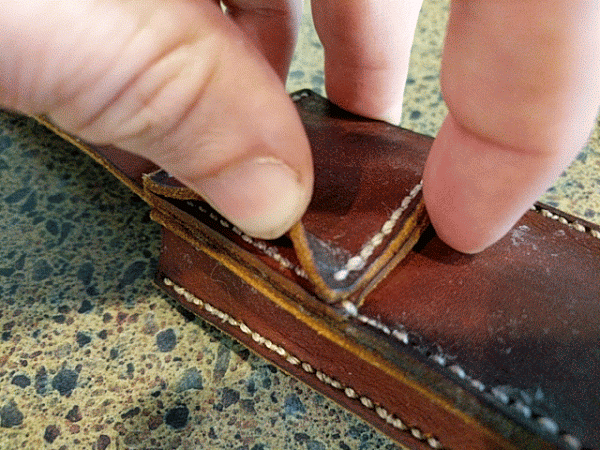Even before the ![]() arrived, as the e-mails started to let folks know when they’d get their mighty machine, I knew that I needed a new, not-terrible belt pouch for my much-loved multi-tool.
arrived, as the e-mails started to let folks know when they’d get their mighty machine, I knew that I needed a new, not-terrible belt pouch for my much-loved multi-tool.

I’ve had the thing for seventeen years, and the nylon pouch with which it came has been replaced twice - it seemed to me time for something a bit tougher in leather. I had done some leatherworking as a teenager, and @dan’s wallet story reminded me that the worst part - cutting holes with a thonging chisel - was now easily automated.
I took some measurements, opened up OpenSCAD, and designed the shapes that I need. I mostly held the design in my head; the OpenSCAD models don’t tell you anything about how they go together. I just needed a way to precisely place and align things in an SVG - I’m no expert whatsoever at Inkscape (or for that matter, OpenSCAD)
I’d hoarded some leather scraps for a few years, so those came out, and rather than doing the responsible thing, I just told the machine it was “standard natural leather.”
The first attempt failed, but was really close to good. The problems I had were:
- OpenSCAD SVG export applies a “stroke” to the path, so without thinking I used Inkscape to “Stroke-to-Path” the thing. That doubled all the cut lines, about 0.5mm apart.
- Doubled cut lines dumped too much heat into the leather, making it very slightly more brittle, which wouldn’t have been a problem except
- My design had stitch holes 2mm apart and 2mm from the edges - that was simply too close. Leather failed around the tight curves, or sometimes simply from pushing the sewing awl through.
- 2mm stitch spacing just made this too fiddly to do with the big needle in the sewing awl.
So back to OpenSCAD to make some revisions:
- Recalculated for holes 3mm apart and from the edges.
vifor setting the units to mm, as well as for simply removing the ‘stroke’ elements from the paths.
Same power settings, which for this leather, simply weren’t quite high enough. I had to go over it with a razor to free the part. My fault, but lesson learned.
The holes were still a bit too small for this awl, but I decided that I could live with it. I had to figure out how to close the thing, though, and settled on a neodymium magnet which sticks to the multi-tool. I haven’t decided yet whether I think the fact that the pouch will not close without a tool in it is a bug or a feature ![]() The magnet’s just very carefully glued in place; CA and hot glue. We’ll see if that lasts very long.
The magnet’s just very carefully glued in place; CA and hot glue. We’ll see if that lasts very long.

The belt loop part is two pieces, so that the pouch can be worn vertically or horizontally. This was a feature of the original pouch that I really appreciate.

And here it is, in place, doing its job, horizontally, just after I finished the magnetic closure:
Sources are here:
https://github.com/StripeyType/laserables/tree/master/pouch




